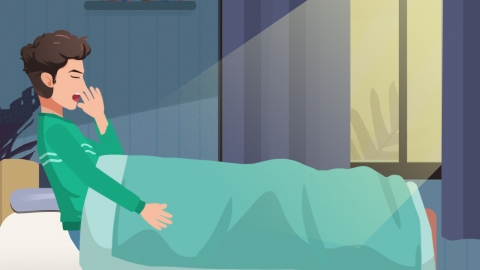What causes one-sided nosebleeds upon waking up in the morning, and what should I do?
In general, waking up in the morning with nosebleeds occurring on one side could be caused by factors such as dry air, nasal trauma from picking, rhinitis, deviated nasal septum, or hypertension. It is recommended to seek medical attention promptly to identify the underlying cause and receive appropriate treatment under a doctor's guidance. The specific analysis is as follows:

1. Dry air: Overnight dry air can cause excessive evaporation of moisture from the nasal mucosa, making it fragile and prone to rupture, leading to one-sided nosebleeds. This commonly occurs during autumn and winter seasons or when using air conditioners or heating systems. Using a humidifier in the bedroom before sleep to increase indoor humidity, drinking more water to replenish fluids, and applying erythromycin ointment inside the nasal cavity can help keep the mucosa moist and prevent worsening dryness.
2. Nasal trauma from picking: Unconsciously picking or rubbing the nose at night can damage the mucosal blood vessels on one side of the nasal cavity, causing nosebleeds upon waking, often accompanied by mild nasal discomfort. Breaking the habit of picking the nose, leaning forward with the head lowered during nosebleeds, and pinching both sides of the nostrils with fingers to apply pressure for hemostasis are recommended. After stopping the bleeding, normal saline nasal irrigation can help promote mucosal healing.
3. Rhinitis: Allergic rhinitis or chronic rhinitis causes nasal mucosal congestion and edema, making the submucosal blood vessels fragile. Nasal bleeding may occur easily upon morning stimulation, accompanied by nasal congestion and sneezing. Patients with allergic rhinitis can follow medical advice to use medications such as budesonide nasal spray, loratadine tablets, or cetirizine hydrochloride drops to relieve inflammation. Patients with chronic rhinitis may use mometasone furoate nasal spray or "Bi Yuan Tong Qiao" granules to reduce mucosal congestion and bleeding.
4. Deviated nasal septum: A deviated nasal septum bends toward one side, making the mucosa at the deviated site thinner and more susceptible to airflow irritation and rupture, typically causing fixed unilateral bleeding, often accompanied by nasal congestion. Mild symptoms can be managed by avoiding irritants and maintaining nasal moisture to reduce bleeding. If frequent bleeding occurs, septoplasty may be required to correct the deviated nasal septum and prevent recurrent mucosal injury and bleeding.
5. Hypertension: When blood pressure fluctuates and rises, the pressure within nasal blood vessels increases, making one-sided nasal bleeding more likely. The blood is typically bright red and accompanied by dizziness and headache. Patients should follow medical instructions to use antihypertensive medications such as nifedipine sustained-release tablets, amlodipine besylate tablets, or valsartan capsules, monitor blood pressure regularly, avoid emotional excitement and strenuous exercise, and reduce the risk of bleeding.
In daily life, maintaining appropriate indoor humidity, avoiding nasal irritation, and developing good hygiene habits are important. If one-sided nosebleeds occur frequently or involve heavy bleeding, record the timing and triggers of the episodes to help doctors identify the cause and provide targeted treatment, thus maintaining nasal health.








